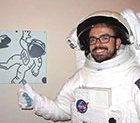What are you working on at JPL?
I am on a study team exploring options for a pair of missions that could take key next steps to bring samples back from Mars. I work in JPL’s Mobility and Robotics Systems section. I was primarily brought on to do visuals that translate what the mission concept is designed to do in a more cinematic and visual way so people can understand it. However, since getting here, I've been wearing multiple hats: working on visuals but also picking up my engineering hat from back in the day. I’m illustrating scenes for the Mars Sample Return study and conveying my ideas for a transportation vessel that could be used for the endeavor. The bit of engineering experience I had when I was younger has helped me understand and elaborate on the functional and mechanical side of these ideas. I'm absorbing all the knowledge, learning terminology and really getting into it – living the dream as an intern!
What is a typical day like for you?
What's most important for a designer or design student is to get out your ideas. You've got to keep the practice up. So I actually sketch every morning. If you look at the wall above my desk, it's all sketches: random sketches and concept satellites, maybe some entertainment ideas, some cars here and there, spaceships – who knows? – just anything to keep my juices flowing and keep my creativity going. Then, I put that creative mind to rest for a little bit and start again.
I’ve also been working on matrices to evaluate the criteria of sample-return mission concepts and the types of innovative variations that would be compatible within the whole system. My work as a designer also comes into play when I create both visual and verbal documents that will help stakeholders understand technical aspects of the designs.
When I get home, I’ll maybe have a snack or relax and unwind, then sketch a little more before I go to bed, and do it all again.
What was the ultimate goal of your project?
I really want to convey the options for Mars Sample Return in a very cinematic way so that people can remember it. And then in terms of the engineering side, before I leave, I want to conceive a concept for a system to help transport the Mars samples once they have been captured that would be innovative but also be realistic and work within the aerospace parameters.
How might your project help the average person one day?
I'm conveying the entire story, from liftoff in 2020 to getting to Mars, collecting samples, potentially getting back up off the surface and heading back to Earth. I think it'll help people remember what Mars 2020 is all about and how it fits in the larger story of future missions that may return a sample to Earth. Hopefully they'll remember those images for years, along with the whole mission's success.

What is the most JPL- or NASA-unique experience you've had so far?
So many! Meeting the awesome interns. Seeing everything around JPL that's being developed and tested. That's so cool. Also, the intern before me is now interning at NASA’s Armstrong Flight Research Center in the Mojave Desert. He invited the whole team to go visit. We got to see the F-15B Eagle that is being used for NASA research. We looked at concepts they're coming up with – just crazy stuff like you'd see in movies, but it's actually being built!
How do you think you're contributing to NASA/JPL missions and science?
I think bringing the visual-designer mentality to this engineering-driven community is really good. I think that designers can contribute to these kinds of communities. We can help engineers translate ideas really fast. Maybe there are some skills that engineers lack in design and some skills that designers lack in engineering, but when they come together there's a good balance of work output and ideas, and a good combination of solid engineering and design aesthetics coming together to create a beautiful machine. There's beauty in function, but there's also beauty in function being balanced with an appropriate aesthetic.
If you could travel to any place in space, where would you go and what would you do there?
I get really sci-fi about this stuff. Imagine a theoretical scenario in which you have infinite timelines moving in parallel. Let's say it's like a guitar, and each string is you on a different timeline, moving in different places with different stories. If there is somewhere I can go that's either inside this galaxy or outside that can bring me to these different timelines and lets me come back and explore my own reality or different realities, that's where I want to go.
This Q&A is part of an ongoing series telling the story of what it takes to design, build, land, and operate a rover on Mars, told from the perspective of students interning with NASA's Perseverance Mars rover mission. › Read more from the series
The laboratory’s STEM internship and fellowship programs are managed by the JPL Education Office. Extending the NASA Office of STEM Engagement’s reach, JPL Education seeks to create the next generation of scientists, engineers, technologists and space explorers by supporting educators and bringing the excitement of NASA missions and science to learners of all ages.
Career opportunities in STEM and beyond can be found online at jpl.jobs. Learn more about careers and life at JPL on LinkedIn and by following @nasajplcareers on Instagram.

